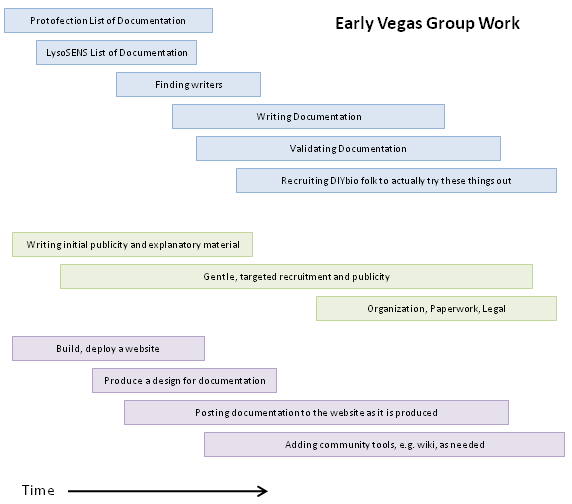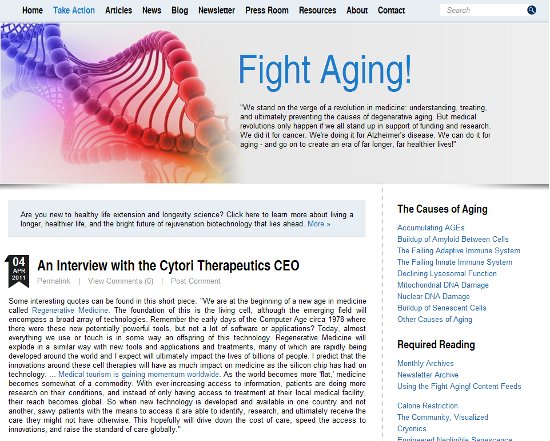UPDATE 05/21/2011: The Vegas Group initiative launched soon after this post, and was quickly renamed to Open Cures, with a new website and a new mailing list. Please do drop by and take a look at what we're working on.
The Vegas Group is a yet-to-be-built community initiative intended to bring longevity science to the open biotechnology and DIYbio communities - and from there reverse engineer and make ready for human use the most promising longevity-enhancing technologies demonstrated in mice in the laboratory. We are entering an age of medical tourism, and the clinics and laboratories of Asia will be happy to accept business and open source biotechnologies generated by DIYbio work in the US. At this stage, I'm still thinking through the project: breaking it down into manageable chunks, and considering what I should work on first:
The path to this future involves networking and community building in a whole new and different direction from that taken by much of the longevity advocacy community - and the construction of a codex of information, a how-to manual of recipes for replicating specific products of the formal research community in longevity science. ... any step one for me will involve considering the codex: what it is, and how it will be constructed, maintained, and made useful to the seeds of what will be the Vegas Group - however that organization ultimately comes about, and whatever form it ultimately takes.
As the cost of biotechnology falls, so is the door opened to much wider development and innovation, wherein lab cooperatives host a mix of hobbyists, moonlighting professionals, and semi-professionals who collaborate on a range of their own projects. Ultimately, low-cost desktop biotech toolkits will be developed and a community of tens or hundreds of thousands of developers will contribute from their homes - just as is the case for open source software development today. With computers in mind, a good historical analogy for the present state of the small DIYbio community is in fact the Homebrew Computer Club in the mid 1970s, prior to the introduction of the first popular personal computer kit. Some small but enthusiastic individuals and groups are designing, building, and selling biotech hardware - such as PCR machines - that will ultimately be the components of a home laboratory, but matters are not yet at that stage of take-off that will see dozens of companies founded and many more people join the community in a short period of years. That lies ahead. The wave is coming, in its own time, and I would like to be positioned to take advantage of it.
All journeys start with the first steps, and I'm in favor of incremental approaches to development. Make something small, a minimum viable product that is the most elementary building block that can stand on its own and still contribute to the ultimate goal. Release it, obtain feedback, and then start on the next building block - and repeat that process until you have as fully as possible realized your initial vision. There will be much to learn along the way, and small building blocks coupled with "release early, release often" make that learning less painful.
Given a large idea, the challenge is often finding that starting point. From the broad high level outline of the Vegas Group, I focused on the codex: the necessary how-to documents and body of knowledge that will enable people to participate. As a general rule, technical communities are terrible at documentation - and that lack of documentation is a real hurdle to recruitment and growth. It could be argued that the DIYbio community isn't yet at the point where it could benefit greatly from a codex: there are other tasks to be completed first relating to hardware. But time is ticking, and progress is being made. The period of being too early won't last forever, and establishing even the skeleton of a practical longevity science codex at hobbyist or non-profit speed will be a process that takes years.
The codex itself is a very large project: something large enough to found a company on in and of itself. There are any number of questions: how best to discover the business models that work to efficiently produce accurate reverse engineering from published papers on longevity-related biotechnology; how best to structure the information presented; how to organize writers and researchers; how to even assemble and prioritize the list of materials needed; and so on ad infinitum.
Thus a fairly narrow initial project for the codex must be identified, so that the first group of volunteers to work on it can run into all the brick walls and fall into all of the potholes without risking a great deal if it all fails. Small projects are easy to scrap, rework, and start over if necessary - and that is a tremendous advantage when you don't yet know the detailed recipe for success. Along the way the volunteers will come to an understanding of how best to make assembly of the broader codex work as a process.
What is this first codex project, though? I propose that reverse engineering and documentation of mitochondrial protofection is a good candidate. This is a technique by which mitochondrial DNA is replaced throughout an individual's cells, and was first demonstrated in mice back in 2005. As you might know, progressively accumulated damage to mitochondrial DNA is one of the causes of aging, as described by the mitochondrial free radical theory of aging. Future rejuvenation biotechnology must include a way to either permanently work around this form of damage, such as through the methodology advocated by the SENS Foundation, or periodically repair it - say once every two to three decades.
Why protofection? In a nutshell:
- It is comparatively easy to explain to a non-technical audience.
- It fits with the SENS vision for rejuvenation biotechnology.
- It has already been demonstrated to work, so at least one group of researchers knows exactly how to do it.
- It is old enough that this and related knowledge may have spread somewhat, making it more amenable to reverse engineering.
Protofection works in mice, but since that demonstration six years ago next to nothing has been heard of it - just a few publications indicative of a slow exploration in search of possible FDA-approved applications. The FDA does not consider aging a disease, however, and therefore its regulators will not approve any treatment that aims to intervene in aging or achieve rejuvenation. That unfortunate fact is well known, and thus there is little funding available for attempts to treat aging: potential technologies are instead subverted into the development of limited treatments for late stage age-related diseases. The silence regarding protofection is probably another good example of the way in which the present regulatory apparatus holds back progress, as developing protofection for safe general human use is an obvious course of action based on the weight of evidence linking mitochondrial DNA damage and aging. Yet it isn't happening.
Given that a number of years have passed since the viability of protofection was demonstrated, it should be an easier target for reverse engineering and documentation of processes than more recent developments. By which I mean that it should be easier to find researchers and post-graduates unconnected with the work who nonetheless know enough to write on the topic.
Protofection is also (I hope) narrow enough not to generate a true mountain of supporting needs in terms of how-to documents. Part of the process of discovery is to understand how to develop the initial list of documents required for the codex, starting from a high-level goal like "let's reverse engineer protofection, make reproducing it comprehensible to the semi-professional DIYbio volunteer, and release that documentation under a Creative Commons license" and working all way down to the brass tacks and petri dishes. Protofection, while something that can be explained in a few short sentences, stands at the top of a sizable pyramid of techniques and knowledge in biotechnology: how to work with DNA, how to manage your own laboratory equipment, how to keep cell cultures, and so on for a long list of topics.
If this takes a few years to get right, that's fine by me. It will provide a blueprint for doing the same to other areas of biotechnology, and by that time there should be more people interest in helping out - both for longevity science and for their own areas of interest.

